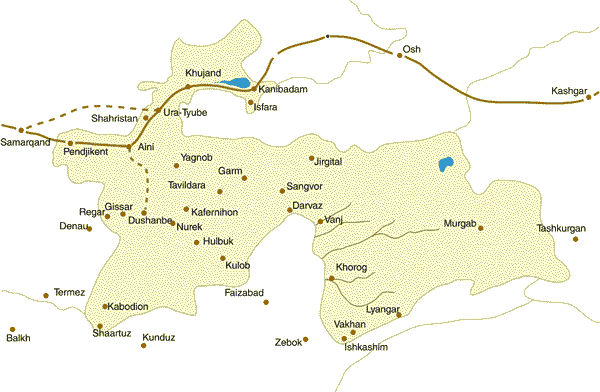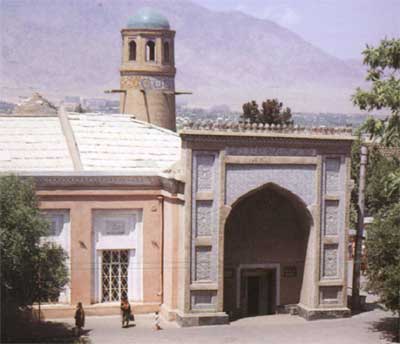|
|
||
|
Run from Samarqand to Kokand through Penjikent, Varz (Aini), Bundjikat (Shahristan), Ura û Tyube, Khojand, Kanibadam and Isfara |
||
|
ISFARA |
||
The
first inhabitants were Iranian-speaking nomads û the Sakas, who lived
here in the first millennium BCE. There are still a lot of burial and
ground mounds, and hill forts, built in the seventh to fourth centuries
BCE.
|
||
|
KANIBADAM |
||
| ò
Mirajab û Dodkho Madrasah (sixteenth to seventeenth centuries)
ò The Kayrokum storage reservoir |
||
|
KHUJAND |
||
During the Akhamenid period, 2500 years ago Alexander the Great pitched a military camp in the eastern forepost of the Persian Empire and called this place Alexandria Eschatia (Far Alexandria). On his orders, the city was fortified with strengthened walls in 329 BCE. (Arian) The Arab-speaking geographers of tenth to twelfth centuries called Khujand ætirozi JahanÆ (æthe bride of the worldÆ). Khujand was behind only Bukhoro and Samarqand in terms of the number of its madrasahs and was home to about 300 outstanding scholars, poets and musicians. ò The Sheikh Muslihiddin architectural complex (eleventh to twelfth centuries). The part of the building that remains intact was built in 1394 on the orders of Timur - the disciple of sheikh Muslihiddin and it was rebuilt in the sixteenth century. There is also an ecumenical mosque next to it. A twenty-one metre minaret was built in a corner of it in 1895. |
||
|
URA TYUBE |
||
| ò
A temple of fire at Ak- Tepa (fourth to seventh century BCE)
ò The town of Nur Tepa; Ura Tyube is one of the most ancient cities in Central Asia. It was founded more than 2500 years ago. It has been identified with Kiropol. The Persian King Kir was killed by its walls. ò The mosque - Kok - madrasah - gumbaz ò The Baba Tago Mausoleum; The city was renowned for its master craftsmen, artists, Suzani embroiderers, master cutlers and Karnai musical instruments. Shahristan û capital of ancient Ustravshan. The Shahristan pass (3372m) with wooded slopes. |
||
|
The town of AIni |
||
| ò
Varz Minor (tenth century), 3.5m. high
ò The village of Dar-Dar û terraces painted on the columns of the mosque (nineteenth century) ò A castle on Mount Much, 3 km. from the village of Khairabad. The first Sogdian documents were found here in 1933. |
||
|
PENJIKENT |
||
| ò
The mausoleum of Muhammad Bashoro (eleventh century), 20 km from the city
ò Upper Zeravshan û a source of high-quality examples of carved wood of the ninth to eleventh century ò Ancient Penjikent, the homeland of the ruler Devashtich (executed in the eighth century) ò In 1995 a relief showing the Indian gods of Shiva and Parvati on a bull was found. |
||
|
SAREZM |
||
| Neolithic and Bronze Age settlement (fourth to second century BCE) | ||
|
Fandarya û Yagnob |
||
ò The Sarvodi fortress ò Coal fires (which have been burning for a thousand years) ò Lake Iskander-kul ò Yagnobians speaking the Sogdian dialect The Sogdians brought ideas and traditions from one culture to another. Researchers have described them as æcultural beesÆ. They adopted Buddhism and spread its teaching throughout the Silk Road, including China. The Central Asian merchants and missionaries spread not only Buddhism, but also ideas about the construction and decoration of temples and the depiction of Buddhas and bodhisattvas to China. Later, the Sogdians converted to Manichaeism and Nestorian Christianity and became representatives of these faiths through their line of merchant communities across the Asian area. They knew many languages; many of them were translators. It was the Sogdians who brought the technology of paper production from China to Europe. During the Islamic period, Samarqand was famous for the quality of its paper. The Sogdians were outstanding traders. The trade advanced pluralism in this region. The rise of Islam is attributed to the success of Muslims in dominating the trade networks around the Indian Ocean basin. Islamic law became dominant and favourable concessions and taxation were extended to Muslim traders in areas under Muslim control. In this way Islam started to spread into the East. The penetration of Islam promoted the Abbasid revolution in 640 in Baghdad and the genesis of a new identity: the Iranian element became predominant in Islam. Persian and then the Turkic languages became the means of extension of the new culture. The role of shrines, temples, mausoleums and sacred places in the development of Islamic culture has been great. Usually pilgrimages to these places were organised by women and children received religious education from their mothers. Chinese sources mention that there were dancers, singersa and musicians in the retinue of the embassies of the æWestern countriesÆ (Sogd and Bactria). During these journeys a great transformation of Chinese music as Central Asian musical instruments were introduced into China. In 718, the Sogdians sent some chain mail to China as a gift, and it was eventually adopted by the Chinese army. |



